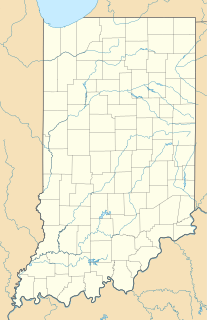The Beaverfoot Range is a mountain range of the Canadian Rockies, located in southeastern British Columbia. The range extends from Cedared Creek near Spillimacheen north to the Kicking Horse River.

Hedley is an unincorporated town in southern British Columbia, Canada, named after Robert R. Hedley, the manager of the Hall Smelter in Nelson. Hedley is located at the foot of Nickel Plate Mountain in the Similkameen. The town had a population of approximately 242 as of 2016. In the early 1900s, Hedley's population peaked over 1,000 people, primarily due to the gold mining industry. The Hedley Museum and the Mascot Mine Museum display artifacts and photographs from this era.
Beaver Creek Provincial Park is a provincial park in British Columbia, Canada.
Boundary Creek Provincial Park is a provincial park in British Columbia, Canada located northeast of the city of Grand Forks in that province's Boundary Country, adjacent to BC Highway 3. The eponymous Boundary Creek flows through the park.
Cody Caves Provincial Park is a provincial park in British Columbia, Canada. It was formed in July 1966 to protect the Cody Caves and was the first subterranean park in British Columbia. The park is 13 km by road, northwest from the hot springs community of Ainsworth on Kootenay Lake.
Choquette Hot Springs Provincial Park is a provincial park in the Stikine Country region of northwestern British Columbia, Canada. Despite the park's name, the official and most commonly used name of the springs it was established to protect is Stikine River Hot Springs. The park gets its name by the springs' proximity to Choquette Bar, site of the first gold strike of the Stikine Gold Rush of 1861 and named for Alexander "Buck" Choquette, the strike's discoverer.
Drewry Point Provincial Park is a provincial park in British Columbia, Canada on the west side of Kootenay Lake, southeast of the city of Nelson.
Eneas Lakes Provincial Park is a provincial park in British Columbia, Canada, located west of the town of Peachland, to the south of Peachland Creek. The park is approximately 1036 ha. in size and was established in 1968. The Eneas Lakes lie at the head of Finlay Creek.
Kootenay Lake Provincial Park is a provincial park in British Columbia, Canada. It encompasses five widely dispersed parks around Kootenay Lake: Kootenay Lake Provincial Park, Kootenay Lake Provincial Park, Kootenay Lake Provincial Park, Kootenay Lake Provincial Park, and Kootenay Lake Provincial Park.

Lockhart Beach Provincial Park is a provincial park Located 40 km north of Creston, British Columbia, Canada, on BC Highway 3A. "This park and the adjacent Lockhart Creek Provincial Park extend 3 hectares, from the sunny shores of Kootenay Lake to the headwaters of Lockhart Creek. "This small park provides the only easy access to public camping along the south arm of Kootenay Lake. An 18 site campground and day use area are located near a sand and fine gravel beach where visitors can relax and enjoy the clear waters of Kootenay Lake."
Pilot Bay Provincial Park is a provincial park in British Columbia, Canada.
Roberts Creek Provincial Park is a provincial park in British Columbia, Canada, located northwest of the community of Roberts Creek, between Gibsons and Sechelt. First created in 1947 with an area of 100 acres (0.40 km2), it was modified in size in 2000 to approximately 40 ha.
Ryan Provincial Park is a provincial park in British Columbia, Canada.
St. Mary's Alpine Provincial Park is a provincial park in British Columbia, Canada. According to the Canadian Ministry of the Environment:
St. Mary’s Alpine Park is a wilderness paradise for the experienced backcountry traveller. Numerous lakes and tarns are tucked against rugged granite cliffs and surrounded by tundra and lingering snowfields. Seven creeks drain the lakes, resulting in numerous waterfalls and cataracts, some as much as 150 metres in height. Experienced hikers, willing to expend considerable effort in bushwhacking and route finding should visit this protected area where few, if any, people will be encountered.

The Goat River is tributary of the Kootenay River in the Canadian province of British Columbia. The river meets the Kootenay near the town of Creston. The Goat River Dam, constructed in the 1930s, was an early source of electricity for the town. Before dikes were built, the river was a major source of spring flooding in the Creston valley.
Scout Lake is a hamlet in the Canadian province of Saskatchewan. Listed as a designated place by Statistics Canada, the hamlet had a population of 20 in the Canada 2006 Census.
Yale First Nation is a First Nations government located at Yale, British Columbia. Yale has 16 distinct reserves stretching from near Sawmill Creek to American Creek, with the most southern reserve situated at Ruby Creek in the District of Kent.
The Salloomt River is a river in the Bella Coola Valley of the Central Coast region of British Columbia, Canada. It is a tributary of the Bella Coola River, flowing southwest out of the southernmost Kitimat Ranges to meet that river just upstream from the community of Hagensborg.
Fernando Salinas is a census-designated place (CDP) in Starr County, Texas, United States. This was a new CDP for the 2010 census with a population of 15.

Cedar Point is an unincorporated community in Turkey Creek Township, Kosciusko County, in the U.S. state of Indiana.






